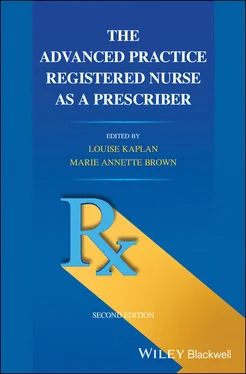Knowledge of the disease and standard management
APRNs continually gain experience and knowledge of the constantly changing area of pharmacological treatment. Rational prescribing is a method of drug management that is well established in international health and has become a cornerstone for prescribing medications to avoid adverse drug events (ADEs). The World Health Organization (2002) defined the rational use of medicines as follows:
Patients receive medications appropriate to their clinical needs, in doses that meet their own individual requirements for an adequate period of time, and the lowest cost to them and their community.
The risk factors for ADEs are patient‐related, drug‐specific, and clinician‐specific. Older adults and children are both more vulnerable to an ADE; however, polypharmacy, the strongest risk factor for an ADE, is more common in adults. Four types of medications – antidiabetic drugs, oral anticoagulants, antiplatelet agents, and opioid pain medication – account for more than 50% of emergency department visits for ADEs in Medicare patients (Agency for Healthcare Research and Quality, 2020).
Some medications may not be appropriate for specific populations. The Beers Criteria and Screening Tool of Older Persons’ Potentially Inappropriate Prescriptions (STOPP) can be used in a complementary manner to evaluate potentially inappropriate medications for adults 65 years or older (Blanco‐Reina et al., 2014). The Beers Criteria identify medications that should be avoided because they are ineffective, they pose an unnecessarily high risk, or there is a safer alternative. The criteria also identify medications that should not be prescribed when the person has specific health problems. The STOPP criteria are organized according to physiological systems and overcome some of the limitations of the Beers Criteria.
Rational prescribing also involves prescription drug costs. One way to reduce costs without compromising high‐quality care is the use of generic drugs. Brand‐name drugs are usually prescribed for patients who have a strong preference or when generics fail or are not available. Safety of brand‐name drugs can also be an issue particularly when a medication is new to the market. There is less information about potential adverse consequences that may become apparent only after years of widespread use. Box 2.1presents some strategies for improving rational prescribing.
Many professional organizations publish clinical guidelines and standards of care that include strategies for prescribing. All APRNs, especially novice practitioners, can benefit from these and other resources. A key aspect of rational prescribing is documentation of decisions. Refer to Chapter 8for a full discussion on the importance of documentation.
Patient education and shared decision making
One of the greatest strengths of APRNs is the ability to develop a therapeutic relationship with patients and provide education. APRNs also facilitate patient learning about pharmacological and non‐pharmacological options. Shared decision making with the patient will result in an individualized plan of care that the patient is more likely to adopt. Emphasis on “knowing the patient” and exploring their attitudes about medication use helps practitioners avoid prescribing when the patient has no intention of taking a medication. A powerful but often overlooked question is imperative: How do YOU feel about the idea of taking this medication?
Box 2.1Strategies for improving rational prescribing
Resist prescribing for minor, self‐limiting, or non‐specific symptoms.
Avoid influences that can cloud rational decision making.
Do not accept gifts that even have the appearance of affecting your decision making.
Balance information received from the pharmaceutical industry with objective, unbiased sources.
Encourage patients to seek out non‐biased sources of information.
Use evidence‐based guidelines and electronic or current print references to assist in prescribing.
Review patient medications during each visit.
Emphasize lifestyle changes and always teach non‐pharmacological management.
Simplify and discontinue medications whenever possible.
Avoid empirical treatment.
Reduce the number of pharmacies and providers whenever possible.
Titrate medication slowly.
Monitor non‐prescription drugs and treatments.
Sources : Farrell et al., 2003; Fick et al., 2003; Fulton & Allen, 2005; McVeigh, 2001.
Only the United States and New Zealand have direct‐to‐consumer advertisement about medications with both positive and negative effects on patients (Filipova, 2019). Advertisements inform people about medications and symptoms related to certain disorders, promote information seeking, increase use of appropriate drugs when underuse is present, and improve the patient’s perception of their interactions with providers. Advertisements may also influence consumers to request unnecessary or inappropriate medications or interfere with medication adherence, all of which makes rational prescribing more difficult (DeFrank et al., 2019). APRNs, through education and counseling, can help patients understand these external influences and make an appropriate decision that reflects rational treatment choices.
Shared decision making should include a discussion of whether the use of medication is physically and financially sustainable, the accessibility of the treatment, and the ease of use. Patients should be informed of the most common and serious side effects as well as key monitoring tests that contribute to patient safety. For example, a psychiatric NP will need to monitor levels of lithium at periodic levels to avoid toxicity. Many patients have conducted considerable Internet research prior to their visit which prompts medication questions or issues. Through education, a patient is provided with relevant facts to make a decision about whether to take a medication. Consent is typically verbal, but there may be situations in which written consent is obtained such as when prescribing a medication “off label,” i.e. when a medication is prescribed for a reason not approved by the Food and Drug Administration (FDA).
The APRN should work collaboratively with pharmacists who are experts in their field to educate patients about their medications. Patients may read information about medications and become fearful of the potential side effects and thus do not fill the prescription or do not take the medicine once obtained from the pharmacy. This requires a balance between providing too much and providing too little information about medications. At a minimum, patients should be sufficiently informed to understand the action of a drug, the dosage, and the most common and severe adverse reactions. They also need to be informed about how to handle common problems, missing a dose, follow‐up if the drug is not effective, and under what conditions the medication can be discontinued.
It is also important to provide guidance about how long the patient should expect to take the medication, particularly for non‐communicable conditions. A guiding principle of prescribing is to use the lowest dose for the shortest period of time possible. An ideal medication is one that is effective with minimal or no side effects and is low cost. Sometimes the patient’s health issue resolves. Lifestyle modifications such as exercise and sodium reduction may result in lowered blood pressure. In other instances a person may need antihypertensive medication despite these modifications.
Maintaining a trust relationship with the patient
APRN prescribing is based on recommendations about medications that reflect the patient’s best interests. Decisions also reflect patient preferences. Additionally, the APRN should guard against participating in relationships that conflict with the patient’s best interests. Licensed prescribers in the District of Columbia’s Medicare Part D program who accepted gifts from pharmaceutical companies were more likely than those who did not to take gifts to prescribe more medications, more expensive medications, and more brand‐name drugs (Wood et al., 2017). Although voluntary rules are in place to limit the relationships with and gifts from pharmaceutical companies, sample medications provided at the clinic by a company’s representative and educational programs continue to influence practitioners.
Читать дальше












